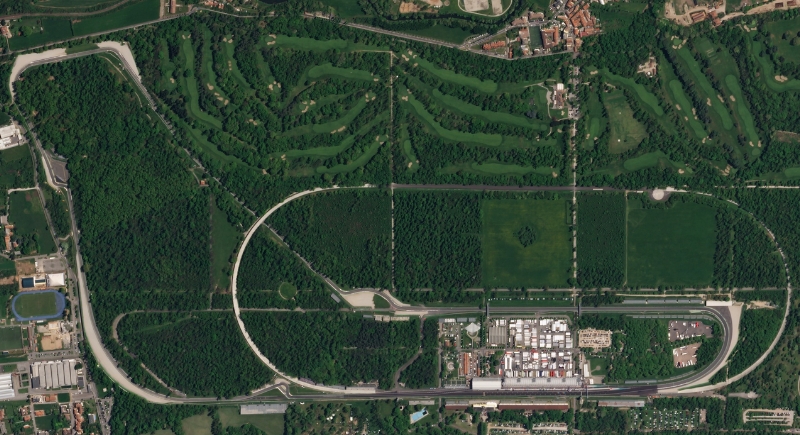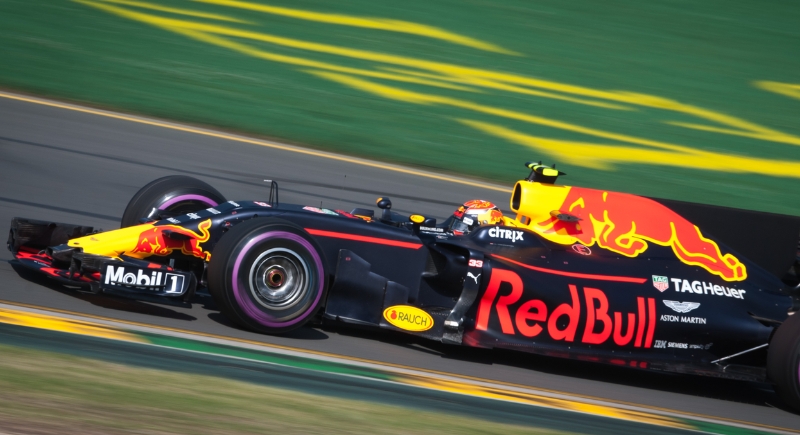How Max Verstappen Drove the Single Fastest Lap Formula 1 Has Ever Seen
Formula 1 has always been about pushing the limits of speed. That’s why a lap quicker than anything seen before carries so much weight. Fans remember legendary qualifiers—Montoya in 2004, Raikkonen in 2018, Hamilton in 2020.
Then came Monza in 2025. Max Verstappen put down a lap at an average speed of 164.466 mph and set a new all-time record. It was a fitting moment at the “Temple of Speed,” where many of F1’s fastest laps have been written into history. Verstappen’s pole now tops that list.
The Perfect Mix of Conditions

Image via Wikimedia Commons/Planet Labs, Inc.
Verstappen’s run came down to a mix of updated track conditions and modern car design, among other things.
Lando Norris had already broken Lewis Hamilton’s 2020 record earlier in the same session with an average of 164.323 mph, which by itself would have been enough to make headlines. Then Verstappen crossed the line moments later by trimming the time to 1:18.792. The difference was just fractions of a second, but it pushed him into history.
The resurfaced Monza track played a significant role. New asphalt laid in 2024 gave the circuit more grip than when Hamilton set his mark. That meant more confidence through the high-speed corners, particularly the Parabolica and Ascari. Plus, the slightly adjusted kerbs meant that drivers had a little more room to push without sacrificing control. Verstappen knew exactly how to take advantage.
Aerodynamics also worked in his favor. Current cars, built under the regulations introduced in 2022, generate less drag than the heavier 2020 machines. This makes them quicker on the straights, even if they give up some grip in slower corners. At Monza, where cars spend nearly 80 percent of the lap at full throttle, straight-line efficiency matters most.
A Lap in the Context of History
To understand the scale of Verstappen’s lap, one must look at the names of those who came before him. In 1985, Keke Rosberg became the first driver to break 160 mph in a qualifying lap at Silverstone, doing it while nursing a slow puncture. Nearly two decades later, Juan Pablo Montoya raised the record to nearly 163 mph at Monza in 2004 with his BMW-powered Williams. Kimi Raikkonen then pushed it further in 2018 with Ferrari, only for Hamilton to reset the bar in 2020 at 164.286 mph.
Each of those laps reflected the peak of their respective eras: turbocharged brutes of the 1980s, V10s of the early 2000s, Ferrari’s hybrid in 2018, and Mercedes’ 2020 machine.
Why Verstappen Made the Difference

Image via Wikimedia Commons/Danny Tax
Plenty of drivers had access to the same surface and similar setups, but Verstappen’s ability to push at Monza’s three chicanes separated him from the rest. His approach demanded late braking, maximum speed through the fast bends, and enough traction to hold the advantage in the final sector. It was a display of commitment with risk attached.
Running on low downforce trims the car to slice through the air, but it also makes it twitchy in corners. Verstappen managed to balance that out, something he admitted wasn’t easy. “You have to commit,” he said after qualifying, noting that with little drag holding the car down, one mistake could ruin the lap.
More Than a One-Lap Wonder
Verstappen not only started from pole but also went on to win the Italian Grand Prix in record-breaking style. His victory came at an average race speed of 155.791 mph, the fastest in F1 history, beating Michael Schumacher’s 2003 Monza record. The total race time of 1:13:24.325 was also the shortest ever recorded for a full-length grand prix.
It marked Verstappen’s third win of the 2025 season and his third at Monza in the last four years. For McLaren’s Norris, who finished second, it was another reminder of how small the margins can be. He had gone quicker than Hamilton’s old mark himself, only for Verstappen to upstage him seconds later.
Next season, new chassis and engine regulations are set to slow cars by roughly two seconds per lap. That means Verstappen’s lap at 164.466 mph may remain untouched for quite some time. Even if future cars regain some top speed, replicating the unique combination of fresh asphalt, ideal weather, and a driver in peak form at Monza won’t be easy.
History shows that these records often last years, sometimes decades. Montoya’s 2004 lap held for 14 years. Hamilton’s stood for five, despite technological leaps and faster cornering speeds at other tracks.
A Weekend That Changed the Conversation

Image via Wikimedia Commons/Jake Archibald
Red Bull had gone months without a win before Monza while struggling with consistency through much of 2025. Verstappen himself had called the car “a monster” in 2024 when it was nearly undrivable at the same track. That’s why this result—pole, fastest lap in history, fastest race in history, and a dominant win—was so important.
Even rival team bosses couldn’t help but acknowledge it. Mercedes’ Toto Wolff described Verstappen’s weekend as making “everybody look a bit stupid.”